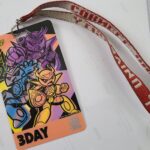Adventures West Coast #5: The Dirty 3-Way Edition

OK, when I first started on this project, I knew that I would have more to say about some books than others. Usually, if it just didn’t resonate with me, I’m going to have less to say. Well, welcome to that installment, as the following 3 books don’t even warrant individual entries. This isn’t to say, however, anything about their quality; unlike most fanboys, I’m going to take the high road, and say that they just weren’t my cup of tea.

First up, we’ve got You Have Killed Me, which is an Oni Press book by Jamie S. Rich and Joelle Jone. Full disclosure: I LOVE Oni Press. I was their account manager when I was with Diamond, and they’re some of the nicest guys in comics. At this point, I’ve read quite a few Oni books, so I’m familiar with their usual creators, as well as the general style of their books. Not to generalize too much, but a lot of Oni books revolve around mid-twenties slackers who get tangled up in some sort of high-jinks. Their most popular example of this genre is the Scott Pilgrim franchise, but it can be seen in other books, like Pounded! and Labor Days. Jamie S. Rich has come to be a master at this genre, and You Have Killed Me is, pretty much, the same thing, only set in an early 20th century, film noir universe.
I’m not even going to go through all of the twists and turns of the plot. If you’ve ever experienced ANYTHING noir, then you already know where this is going: murder, mob, jazz, and a double-crossing dame. That’s it. I felt that it zigzagged more than it needed to, which served to confuse the plot. Another impediment was the artwork of Joelle Jones. It seemed that she was only working with about 5 different character models, so it was difficult to figure out who the characters were at times. Was this the femme fatale in this panel, or was it her dead sister? I know that kind of misdirect was integral to the plot, but it got worse in other places. There was a skinny black character model and a fat black character model. If there were 2 skinnies in the room, you didn’t really know which was which. “They all look the same!” I know Joelle’s a talented artist, as she was responsible for the recent Dr. Horrible one-shot from Dark Horse, as well as some work on Fables. I had been hearing a LOT about this book quite a while before it came out, and I feel that the delays may have been due to the art side of things. In order to get the book finished, I fear she may have cut some corners.
In the long run, I didn’t feel this book lived up to the emo library that Oni has built over the years. If you’re an indie completist, go ahead and give it a try, but don’t say I didn’t warn ya.

Next up, we have Olympus, an Image series by Nathan Edmondson and Christian Ward. Going into this, I knew nothing about the creators or the subject matter. I think I may have said this before, but I know next to nothing about mythology. Yes, I realize they’re the classics, and the learned folks would look down on me for my ignorance. That said, most of the mythology I know is stuff that I picked up from watching Xena and Hercules.
As far as the plot of Olympus, I don’t really wish to get into the details, as I’m afraid I wouldn’t do it justice, given my ignorance of the source material. Over the course of the story, there were points that I could tell would be meaningful to those familiar with the duo, but I was not one of those people. Ultimately, the series followed immortal brothers Castor and Pollux as they alternated between Earth and Hades. It seems that they die every year, only to come back and do it all over again 12 months later. A threat gets loose from the underworld that threatens the immortal realm. So, Castor and Pollux set out to preserve themselves, as well as the rest of their ilk. That’s pretty much what I got out of it.
I will say that the art is the driving force of Olympus. It’s the sort of thing where, even if you don’t wish to read it, you would still get a kick out of “looking at the pretty pictures”. Christian Ward brings a trippy, almost watercolor quality to the book. It can, at times, be a bit hard to follow, but I certainly think it fits the otherworldly nature of the book. I wanted to like this book, as I knew there was good stuff there that I just didn’t understand. There is certainly an audience out there for this book, and I’m just sorry that I’m not it.

Finally, we’ve got Dark Minds, an Image series by Pat Lee. That pretty much says it all right there. If you’re familiar with comics, you know why. If you’re not, here’s the CliffsNotes version: Pat Lee is a bit of a snake oil salesmen in the comic industry. He loves drawing robots, but he ruined his reputation by stealing the work of others – either through outright infringement or lack of payment to artists in his stable (for more, just check his wiki Talk page ),
Well, it seems ol’ Pat’s at it again! I’m gonna make this quick for ya. Have you ever seen Ghost In The Shell? Have you ever seen, pretty much, any anime concerning cyborgs or clones? Then, you already know this story. Hackneyed notions of “I’m a clone, so why do I have these memories?” or the popular “Why is this giant, multinational conglomerate trying to kill me? They created me, after all!”
The most jarring aspect of the book is that it’s almost like it had no editor. It did, however, have an editor: Pat’s brother, Roger Lee. I hope he wasn’t paid. They really could’ve used a crash course with a Scott McCloud book because they don’t seem to understand how to lay out a comic page. The speech bubbles don’t flow correctly, seriously disrupting the flow of dialogue between characters. That same dialogue also sounds like it was written by someone whose native language is NOT English (the Lees are Canadian, so don’t go there with me). The art, too, is flawed, as there are scenes with anatomically atrocious characters posed around immaculately drawn sports cars. Lightbox, anyone?
Dark Minds is an earlier Pat Lee “masterpiece”, and he went on to have a pretty successful career after acquiring the Transformers license for his company, Dreamwave. His financial dealings eventually led to the company’s demise, and he hasn’t worked much in recent years. When this book was published, it was at the dawn of the manga craze. You could shit in a bag and call it “Neo Tokyo”, and fandom would think you were a fucking rock star. Well, Pat Lee was the Elvis of that movement. The King is dead, folks, and it’s about time.



